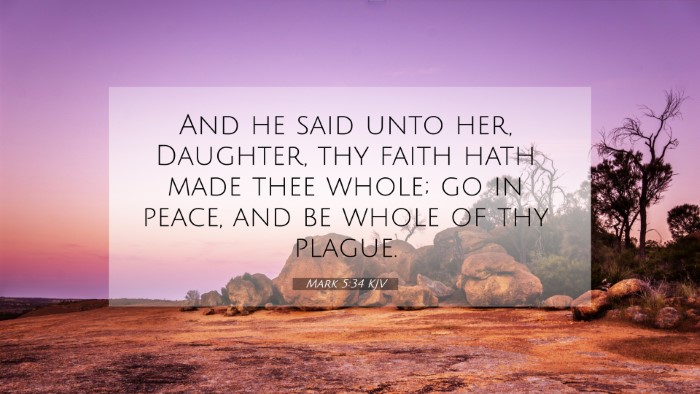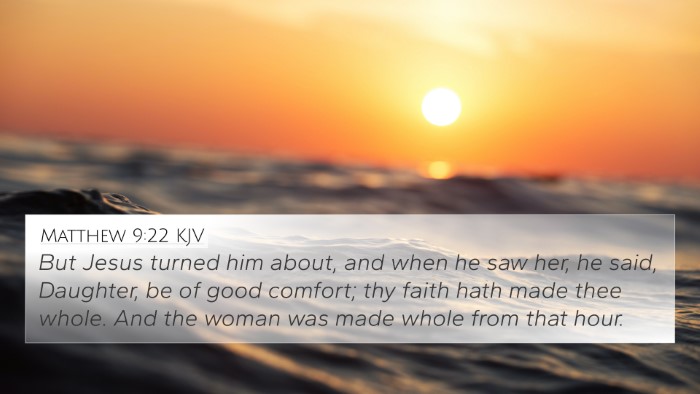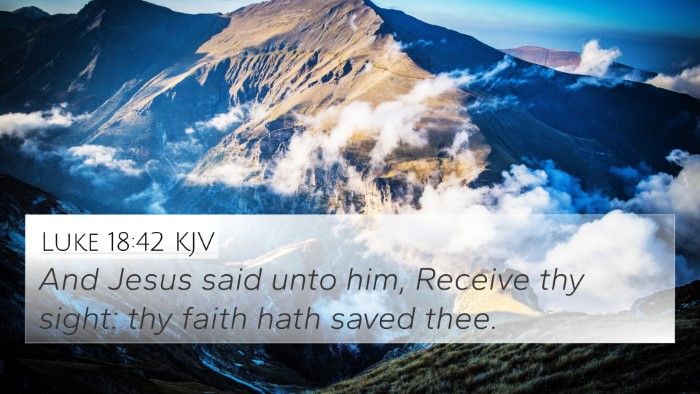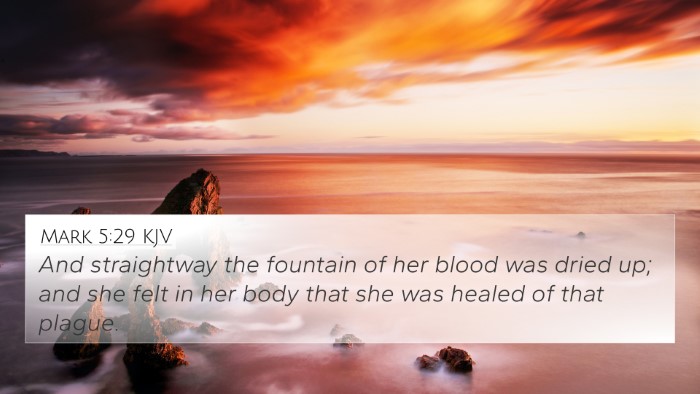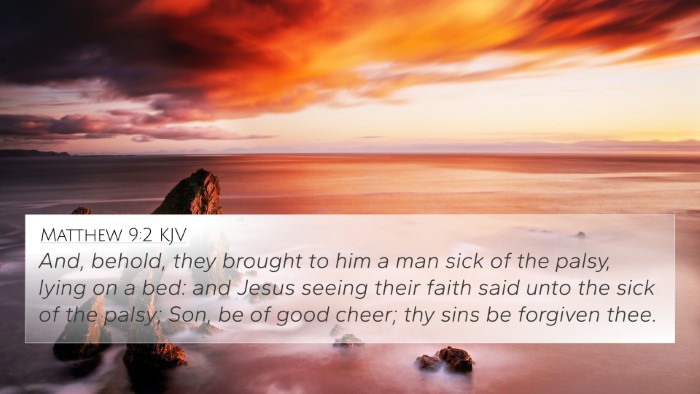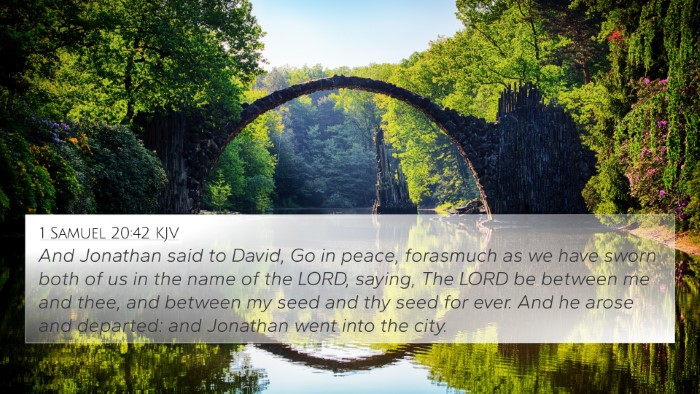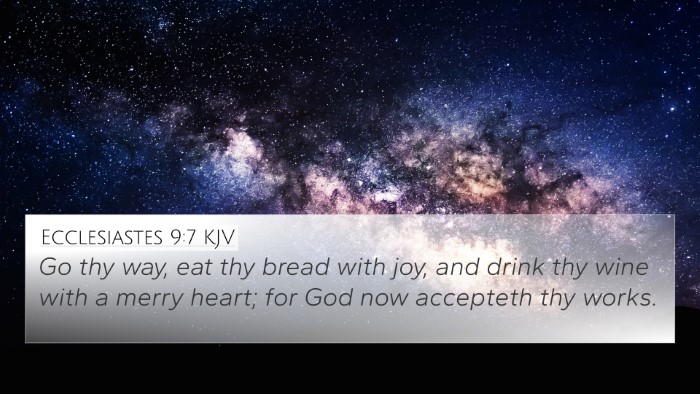Understanding Mark 5:34
Mark 5:34 states: "And he said unto her, Daughter, thy faith hath made thee whole; go in peace, and be whole of thy plague."
This verse captures a moment of healing and affirmation, emphasizing the relationship between faith and restoration. Below, we dive into the meanings derived from various public domain commentaries.
Summary of Key Themes
This verse is situated within the narrative of the woman with the issue of blood, revealing critical themes such as:
- The Power of Faith: Jesus highlights that it is the woman's faith that has led to her healing.
- Divine Compassion: Jesus addresses her affectionately, calling her "Daughter," which signifies acceptance and a deep connection with God.
- Restoration: The phrase "be whole" emphasizes not just physical healing but a holistic restoration of well-being.
Commentary Insights
Matthew Henry's Commentary
Matthew Henry emphasizes that faith is a vital condition for receiving God's mercy. He notes that the woman approached Jesus with a sense of desperation and boldness, believing that just touching His garment would suffice for her healing. Henry elaborates that this act of faith demonstrates her determination and the importance of personal belief in the healing power of Christ.
Albert Barnes' Commentary
Albert Barnes points out that Jesus' words signify that true faith brought about the woman’s healing. He emphasizes that faith is both a gift and a response. By calling her "Daughter," Jesus not only recognizes her faith but also restores her place in the community from which her illness had alienated her. Barnes indicates the transition from sickness to wholeness signifies more than just physical healing; it signals a deeper, spiritual restoration.
Adam Clarke's Commentary
Adam Clarke focuses on the context of the woman's illness and the societal stigma she faced. He notes that Jesus' interaction with her serves to break social barriers, indicating that faith transcends physical and social ailments. Clarke elaborates that the designation "Daughter" transforms her identity from a suffering outcast to a beloved child of God, underscoring the relational aspect of faith in action.
Bible Cross References
This verse connects with several other passages, illustrating the thematic interconnections within scripture:
- Matthew 9:20-22: The account of the same healing event, emphasizing the woman's faith.
- Luke 8:43-48: A parallel account that highlights the details of the woman's suffering and faith.
- Hebrews 11:1: Definition of faith, showcasing the essence of belief in action.
- James 5:15: Discusses the prayer of faith and its role in healing.
- Matthew 15:28: Jesus commends the faith of a Canaanite woman, illustrating faith across different contexts.
- Mark 10:52: The healing of blind Bartimaeus, where faith leads to restoration.
- Romans 5:1: The peace that comes through faith, comparable to the peace granted to the healed woman.
- 1 Peter 2:24: Speaks to the healing provided by Jesus, linking physical and spiritual restoration.
- Acts 14:9: Paul's healing through faith mirrors the theme of restoration present in Mark 5:34.
- John 14:13-14: Assurance of answered prayers for those who believe, connecting faith with divine intervention.
Connections Between Bible Verses
This verse forms an integral part of the broader narrative of healing in the Gospels. The linkage of faith and physical healing is a recurring theme in scripture. Notably, connecting instances of healing (like those of the blind and lame) enriches our understanding of how faith plays a critical role in encountering God's grace.
Thematic Bible Verse Connections
The themes of faith, healing, and restoration can be traced throughout both the Old and New Testaments:
- Old Testament Themes: Stories of healing (e.g., Naaman in 2 Kings 5) highlight the expectation of faith leading to God's intervention.
- New Testament Context: The emphasis on faith in the miracles of Jesus reaffirms the transformative power of belief.
Tools for Bible Cross-Referencing
To further explore the connections between Bible verses, several tools can prove helpful:
- Bible Concordance: A comprehensive list of terms and phrases that help locate verses.
- Bible Cross-Reference Guide: Systems designed to map thematic and contextual relationships between scriptures.
- Cross-Reference Bible Study Methods: Techniques for studying the Bible by linking related verses.
Conclusion
Mark 5:34 encapsulates a powerful moment where faith meets healing. The insights derived from public domain commentaries illustrate the depth of meaning within this brief yet profound interaction between Jesus and the woman healed of her affliction. As we explore cross-references and thematic connections, we deepen our understanding of the pivotal role faith plays in spiritual and physical wholeness throughout the scriptures.


